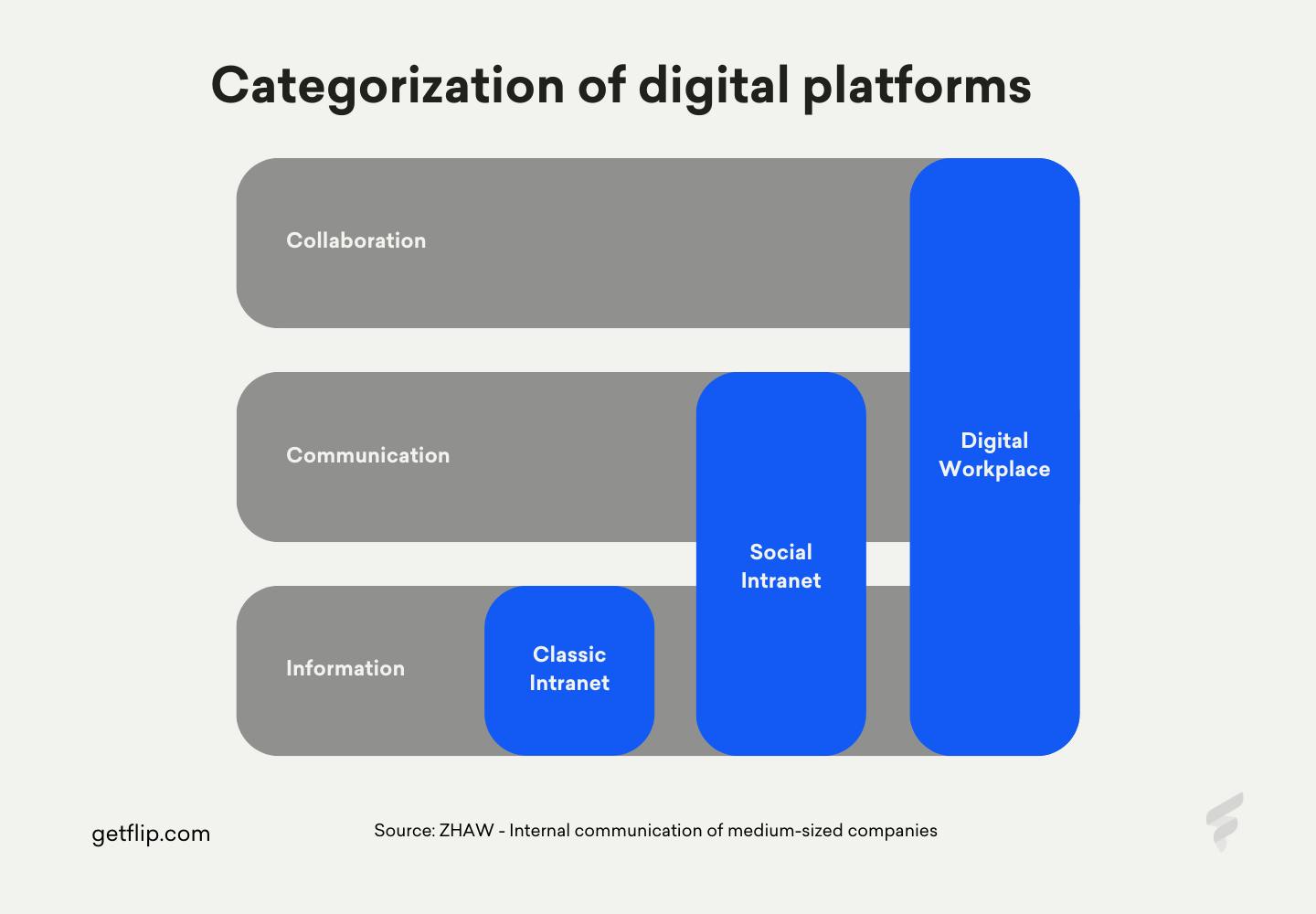01.11.2023
Internal Communications
6 min read


3 alternatives to the traditional intranet: Which tools are worth it?
The intranet has become an integral part of internal communication in many companies. But the traditional intranet has had its day. Find out why modern-day organisations are moving on and which intranet alternatives are worth the investment.
The limits of the traditional intranet
When people talk about the "traditional intranet", they’re primarily referring to content management systems (CMS), which were actually designed for websites and blogs. Even so, some companies today still rely on CMS as the basis for their intranet, mainly because they are familiar to use and the functions are fine for basic communication.
The problem? If a company wants to improve its internal communication and thereby increase employee satisfaction, this traditional intranet is limited. Why? Because the user experience (UX) suffers from the way these intranets are built.
The UX also suffers because communication via CMS-based intranets only reaches those who have a fixed desktop workstation. It leaves out operational employees, also known as "frontline employees", those who, for the most part, don’t work at a PC but on the assembly line, in the warehouse, or at the cash register.
Definition: This is an intranet
The intranet is an internal company or organisation computer network based on the TCP/IP Internet protocol. It is used to support internal company processes.
Source: Gabler WirtschaftslexikonFirst intranet alternative: SharePoint intranets
Internal communicators often struggle to find a social intranet that suits their own company and its requirements. One experiment that some communication departments are trying is SharePoint intranets, which work on the basis of Microsoft's SharePoint cloud service. To do this, so-called “web parts” are put together like building blocks to create a page with text and image elements.
The advantages of SharePoint as an intranet
When it comes to the advantages of this SharePoint solution for the intranet, one point stands out: the cost factor. As the cloud service is included in the Microsoft 365 licence package, companies that have the corresponding licences initially incur no additional costs.
With regard to classic top-down communication, which is important in every company, this form of intranet is sufficient. Internal communicators can create content and publish news or other content in this way.
Another benefit is that once the technical infrastructure is in place, the user experience via the browser can be very appealing—which means that employees actually use the intranet.
However, SharePoint intranets have a long way to go before all the technical adjustments are right, which brings us to the disadvantages of this intranet alternative.
The disadvantages of SharePoint as an intranet
Even if the advantages of the SharePoint intranet are alluring, it is the disadvantages that usually lead to SharePoint being axed as an intranet alternative during a company’s decision-making process.
If the SharePoint intranet has very specific requirements, extensive technical tricks are necessary, which can result in additional costs. This doesn't just mean financial costs but also time costs. In general, this type of intranet requires a relatively high level of maintenance, and each update requires a certain amount of IT resources. This is particularly challenging for small and medium-sized companies.
Another disadvantage: Sharepoint intranets can become complicated and confusing, especially if many features are integrated without prioritising them. The consequence of this is that the company's workforce doesn't actually end up using its intranet. To make the intranet more popular, companies need to offer training courses to help employees overcome this hurdle.
A report by the AIIM (Association for Intelligent Information Management) shows that two-thirds of companies that use SharePoint attribute the low user rate to the fact that the system is too complex and employees are not sufficiently trained.
For companies with a very large proportion of operational employees, the SharePoint intranet is unlikely to be the best option. Employees who have limited or no access to a PC need a mobile solution to be able to access or participate in all relevant communication.

Information, communication, collaboration: a digital work platform such as an employee app includes all important aspects.
Second intranet alternative: Microsoft Teams
Originally introduced as part of Microsoft 365, Teams has developed into a standalone platform for communication and collaboration in companies. With Teams, employees can chat, host video meetings, share files, and collaborate on documents—even via a smartphone app. But is the system landscape sufficient to function as a supplement to the intranet or even as a standalone social intranet?
The advantages of Teams as an intranet
Probably the biggest plus point for Microsoft Teams as an intranet is the fact that the platform is ideal for communicating and collaborating. In addition to video conferencing, the platform has a chat function for groups as well as a way for employees to organise themselves in team channels.
Another advantage of Microsoft Teams is the ability to share files and work together on Word, Excel, or PowerPoint documents embedded in Teams. The tool clearly goes beyond the pure chat and call function. However, these features do not make Microsoft Teams a full-fledged intranet.
The disadvantages of Teams as an intranet
Even though Teams has become a permanent fixture in the internal communication of many companies, the Microsoft program lacks a few things to be considered a serious alternative to a social intranet.
For one, there is no newsfeed and no static content pages. There is no way to display editorial content in a user-friendly way. And when it comes to communicating in very large groups, the platform has its limits. The same applies to knowledge management.
As with the SharePoint intranet, companies with a large number of frontline employees should opt for an intranet version based on MS Teams that is also optimised for the mobile experience. This is the only way to reach all employees at any time and any place. But what could such a solution look like?

Employees don't make coffee, sit in the break room, and read company information.“
Patrik Kolligs, COO of Kronsteg GmbH,
about the need for a modern intranet for internal communication
Third intranet alternative: Employee app
Let's now move on to another alternative for the traditional intranet that has recently come into the spotlight more and more: the employee app. The idea behind an employee app is to simplify a company’s internal communication while giving all employees access to all the information they need—anywhere, at any time.
However, a good employee app doesn't just stop with internal communication. In the best-case scenario, the app functions as an employee platform where tools, processes, and information come together. This means employees have the entire company in their pockets and don't have to deal with multiple tools. Ideally, the software is available not only as a smartphone app but also as a desktop app. That's exactly the case with Flip's employee app.
Why the employee app is often the best option
Of course, you can't say across the board that all companies should purchase an employee app. However, the advantages of an employee app cannot be denied. It is considered one of the most efficient internal communication tools.
The three biggest advantages of an employee app:
1. Information gets through to frontline workers
With an employee app, you can reach those who don't have daily access to a desktop PC. Whether at the supermarket checkout or on the assembly line in production, everyone receives important and current news immediately. This is particularly crucial in crisis communication.
2. Higher employee engagement
But it's not just top-down communication that can be improved. Many companies find it difficult to engage their employees and gather ideas and suggestions from them. An employee app offers the infrastructure to use various channels to establish a digital hub in which all employees are integrated.
3. Everything you need. In one place.
Vacation requests, payslips, shift schedules—operational employees, in particular, often lack direct access to important information. As a digital workplace, an employee platform like Flip bundles all the essentials into one user-friendly app.
Conclusion: New technologies for better internal communication
Even if the limitations of the “classic” intranet are clear, many companies still rely on the somewhat outdated tool for internal communication. When looking for alternatives, some solutions have so many disadvantages that it’s not worth switching to these tools.
However, one of the tools stands out. An employee app like Flip should be considered an option for many companies, especially for mobile employee communication. It bundles tools and processes, enables fast and comprehensive communication, and is quickly integrated into the existing infrastructure of the company. An employee platform also ensures positive digital employee experiences among your workforce.

The golden duo: Flip and the golden M
Would you like to find out more about how Flip improves the everyday work of McDonald's Germany's frontline employees? Here's our success story with the fast food company with the highest sales in the world.
Share
Don’t forget to share this content
Copy








